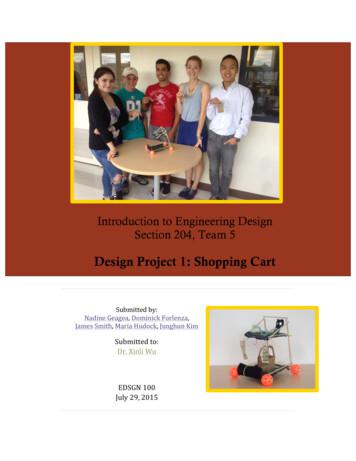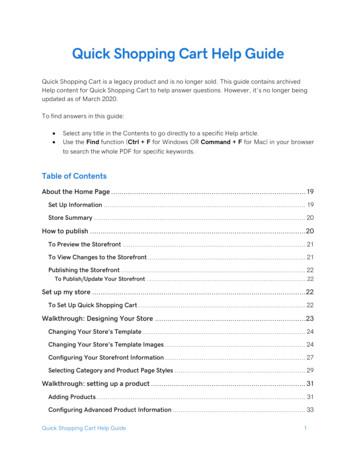Design Project 1: Shopping Cart - Pennsylvania State University
Introduction to Engineering DesignSection 204, Team 5Design Project 1: Shopping uJuly29,2015EDSGN100July29,2015
Executive SummaryThis paper discusses the design of a foldable, easy-to-use shopping cart that can hold 100 poundsand costs less than fifty dollars to produce- unless serving multiple purposes. Customer-needsassessment and the Internet helped determine suitability for groceries and durability mostimportant to shoppers. Cheap, strong materials were appealing and allowed profit.Team 5ii
Table of Contents1. Cover Page . .(Nadine)2. Abstract (Dominick) . ii3. Introduction3.1 Issue Summary (James). . . 14. Description of Design Task4.1 Problem Statement (James) . . . 14.2 Mission Statement (James) . 14.3 Design Specifications (James) . .15. Design Approach5.1 Project Management (Gantt Chart) (Nadine). . . .25.2 Customer Needs Assessment (Maria) . . 35.3 Concept Generation (Maria) . . . .3-65.4 Design Selection Matrices (Maria) . . .7-96. Final Design and Prototype6.1 Working Drawings (Maria, Kim, James) . . . 9-106.2 Prototype Scale and Images (Maria) . . . . 116.3 Design Features (Nadine) . . . . . . 11-126.4 Operation Instructions (Nadine and James) . . . . .127. Engineering Analysis7.1 Working Mechanism (Kim) . . . . . 12-137.2 Cost Analysis (Kim) . . . . . 148. Conclusion8.1 Summary (Maria) . . . . . 14-159.Acknowledgements (Nadine) .1510. References (Dominick) 16Team 5iii
3. Introduction3.1 Issue SummaryIn New York City and other highly populated areas it is often difficult to find a way totransport groceries due to the lack of vehicles and due to high-rise buildings. The Engineer’ssolution: to build an economical and storable cart. The team conducted a survey was to see whatindividuals cared most about in a collapsible shopping cart. The findings resulted in a shoppingcart that had a variety of storage areas, collapsible, and affordable.4. Description of Design Task4.1 Problem StatementConsumers need an easier way to transport groceries by foot after leaving the store. Thetransportation means must have a reasonable capacity and be collapsible for easy storage.4.2 Mission StatementIn order to provide a more convenient and reliable means to transport consumer goods byfoot at a minimal cost, a collapsible cart with set capacity was conceptually designed andevaluated.4.3 Design Specifications The shopping cart’s bottom frame 3ftx1.5ft with a 3/4” thickness Team 5The height was 3ft. The top frame for delicates is 1.5ftx0.75ft with a 3/4” thicknessThe top and bottom frame are collapsible to the main frame, which is 3ft tall.The shopping cart has two different compartments the top being for eggs, bread, andother delicate grocery items.The bottom could be used for any other groceries (water, soda, other bulky items) thefolding shopping cart material altogether came to a total of 32.57.The shopping cart has a weight capacity of 150 pounds.1
5. Design Approach5.1 Project Management (Gantt Chart)Table 1. Gantt ChartTeam 5 Cart Gantt ChartTaskEndStart DateCompletionDateEstablishing goalsand scheduling2-JulInformationGathering2-JulCost and RiskAssessment9-JulBrainstorming2-JulDesign MatrixSelection9-JulSet of WorkingDrawings(BluePrints)14-JulBuild and TestDesign Prototypes14-JulEvaluate DesignPrototypes14-JulDesignDocumentation andPresentationTeam 5Week Week Week123Week4Week5(7/1)(7/21)(7/28)(7/7) (7/14)100%100%100%100%100%100%100%100%100%21-Jul2
5.2 Customer Needs AssessmentA questionnaire was distributed to evaluate customer needs and preferences in basicconsiderations as well as specialty areas. Below are the summarized results of the distributedsurvey. Audience reported going to the grocery store between 1-8 times every 2 weeks.Most use a car to transport groceries greater than 5 miles, while a cart was reported as themethod of transport for a half-mile commute.A range of 2-15 grocery bags per trip was reported.Commute lengths ranged from 5-30 minutes.Terrain considerations were stairs, uphill sidewalks, crowds, slower-moving elderlypeople in area, and hot cars (consideration for cold foods).Most important factors to the audience were having separate compartments to keepcrushable/breakable foods safe, raw meat separate, cold foods preserved, comfort andspeed of use.Most consumers would not prefer to pay more than 20 for a cart.Average scores for qualities rated on a scale of 1-5 (5 is most important):Table 2. Average Design ScoresEase of use:4.8Durability:4.8Weight capacity:4.3Collapsibility:4.2Cost:4.0Weight of cart:4.0Safety:3.8Attractiveness:2.2These results were used to drive creative design features and to determine and factor importancefor the weighted design matrix. The initial six designs inspired by these criteria follow.5.3 Concept GenerationThe team members each developed 3-5 rough sketches to represent various cart concepts.After discussing each, the following six designs were chosen to continue for further evaluation.Team 53
DESIGN A: Premade BasketsAfter browsing online for costcontained materials, a simple designutilizing premade grocery basketsin a minimal metal frame wasconceived. With this design,groceries would be placed inbaskets that rested in a collapsibleframe. The baskets could beremoved for easy unloading ofgroceries. After, the frame wouldfold up and be placed in thestackable baskets for storage.Figure 1. Design ADESIGN B: Folding BriefcaseThis extremely compact design focusedon ease of use, collapsibility, andattractiveness. The flat, compacted cartcould be carried easily in the hand,looking as stylish as a standard briefcase.Flaps fold up from each side of the caseand are stuck together with Velcro toform a wagon-like cart with telescopingdragging handle for use. Straps are alsoused to hold the case together whenentirely folded. Caster wheels swivel inand out of grooves in the case for evenflatter storage.Figure 2. Design BTeam 54
DESIGN C: Zipper CollapsibleThis cart design focused oncollapsibility and easy itemremoval. It can be madeextremely compact because ofsimple cloth construction ontop of a rolling platform. Azipper runs from the base tothe top of the expanded cart bycircling around it severaltimes, allowing for eitherinternal divisions or foroptional sizes. The more thecloth is zipped, the larger thevolume of the higher bag. Themore the cloth is unzipped, thelarger the fabric strap forpulling and the easier theaccess to itemstowards thebottom of the cart no bendingand reaching into the cart). A handle is used to pull the rolling platform around.Figure 3. Design CDESIGN D: Nylon Strap FoldoutThis design makes use of verydurable yet economical materials and simpledesign. A metal frame forms two platformssuspended and spanned by strong nylonstraps. A small upper basket keeps breakablegroceries separate from large items on thebottom. Straps allow the frame to fold upinto a tall and flat storable form.Figure 4. Design DTeam 55
DESIGN E: Fishnet Basket with ScooterThis design incorporates afold-down scooter foot boardto make pushing easier andadd a second use. A fishnetbasket holds a large volume ofgoods without adding a lot ofweight, while nylon strapsacross the bottom supportheavier items. The basket foldsdown and the bottom platformand scooter boards fold up toyield a wider-than-others, butstill compact, folded cart. Ahandlebar serves both to guidethe scooter/cart and to carrythe folded item.Figure 5. Design EDESIGN F: Accordion Folding CartThis design works like the compressible water bottlesof a stiff plastic. It can be expanded by pulling up theplastic walls to be self-supporting, and a bit ofdownward effort on the top faces gives a compressedform. An inner shelf sits between the plastic ridges toseparate food items. Items can be loaded through theremovable top (bottom is accessed by removing shelf).The upper container rolls on a flat platform on casterwheels.Figure 6. Design FTeam 56
5.4 Design Selection MatricesAfter initial concept generation, the six concepts above were evaluated in a simple designmatrix using Design A as the standard.Table 3. Simple Design MatrixSimple Design Matrix - Project IEase of useSuitabilityforgroceriesCollapsibilityCost ofmaterialsWeightcapacitySafetyDurabilitySum Sum Sum 0Net TotalRankCONCLUSION: keep?Design A PremadeBasketsDesign B FoldingBriefcaseDesign C- 00Design DesignEFFishne AccorditonBasket 50251Yes-1-1043-56No-1-1142-35NoDesigns A and D were chosen to continue with potential for improvement, with DesignsB and C chosen to continue as ideas for modification/inclusion.Team 57
After modifications of the designs that were retained from the first design matrix, a seconddesign matrix was used to select the final concept. The categories of consideration were rankedbased on the average rating on a scale of 1-5 given by consumers to the area, converted to apercentage.Table 4. Weighted Design MatrixWeighted Design Matrix - Project IAttractivenessEase ofuseSuitabilityforgroceriesCollapsibilityCost ofmaterialsWeightcapacitySafetyDurabilityTOTAL 2RankingConclusion: keep?Standard PremadeBasketsWeight Scor edScore31.29Nylon StrapFoldout ModifiedSco Weightedre Score31.29ZipperCollapsibleModifiedScor 9120.394no3no1yes2noThe modified version of the original Nylon Strap Foldout cart was chosen to bedeveloped into a conceptual prototype.Team 58
6. Final Design and Prototype6.1 Detail DrawingsFigure 7: Detail 1Figure 8: Detail 8Team 59
Figure 9: Detail 7Figure 10: Detail 4Team 510
6.2 Prototype Scale and ImagesScale Used 1:4Figure 11: Prototype PhotosFigure 12: Cart Drawing with BOMScale Used 1:86.3DesignFeaturesOne of the main design features is the collapsibility of the cart and the fact that it takes upminimal space, as shown in the working mechanism and working drawing. The cart is also ableto withstand over 100lb of force, with a rating of 150lb. The cart also has multiple compartmentsTeam 511
that are available to store delicates on the top basket and more bulky items on the bottom. This ismore than just a traditional shopping cart, with added hooks to store more groceries. There is aspecific place for each different type of grocery. Coupled with its lightweight frame for easytravel, this cart is simple to use but practical at its core.6.4 Operation InstructionsCollapsing the cart1.2.3.4.Unhook top basket from mainframe.Lift up the back of the top basket until it’s parallel with the handle bar.Lift up the bottom unit until it is parallel with the handle and top basket part.It is now in its fully collapsed stage and is ready for storage.Setting up the cart for use1. Pull the bottom basket down until it is fully secured on the ground.2. Push the top basket down until it is aligned with the bottom basket.3. Hook the top basket to the mainframe to fully secure it by resting the hook on the mainbar.4. Cart is fully assembled and ready for use.* Weight capacity is 50lb on the top basket and 100lb on the bottom basket.7. Engineering Analysis7.1 Working MechanismIn order to make a strong and collapsible storage space, a hooked frame with a triangleprofile was used. Swivel connection enables the frame to fold to a smaller form. By using hookattachment, the base leg of the right triangle detaches from the vertical frame and folds inside it.To make sure the frames fold parallel to each other, each vertical pole set (blue, orange, green) ispositioned at a different width. A hook device locks the swivel frames in place for use.Team 512
Figure 13. WorkingMechanism 1On the upper cart basket, thetriangle frame holds up the basket, butthe bottom design needed swivelconnection and fixed connection at thesame time to withstand the weight andto fold in to save space. To solve thisproblem, a rotating locking device was used to hold the vertical frame from falling. The brakedoesn’t stagger the folding mechanism (block bottom frame and upright frame from foldingparallel) because it rotates to the side.Figure 14. Working Mechanism 2The cart is made of 3 big frames: Triangle hook frame, Vertical frame, andHorizontal frame. In order to make theseframes fold into each other, swivelconnection was used in connecting these 3big frames and to make sure they are notinterfering with each other’s folding,Triangle hook frame is located in innerlevel, Vertical frame is in middle level,and Horizontal frame is in outer level.After cart is folded, another nylonstrap is located on the handle so that usercan tie the cart and keep the folded formwithout opening.Figure 15. Working Mechanism 3Team 513
7.2 Cost AnalysisRather than using a solid material like a traditional cart, a combination of hollow framingand meshing was used, saving expenses of materials. Cheap, durable material was needed for themeshing. Nylon was ideal due to its durability and the characteristic of it being fabric. By usingnylon instead of solid metal to make the base, cost and weight was reduced dramatically whilemaintaining superior durability. Cotton net was used as a guardrail for the goods on the basket. Italso allows for it to be attached to the triangle hook frame, and when it is collapsed, not getcaught. However, for future models of the cart, plastic could be utilized rather than the aluminumused for the bars, should a more economical plastic be found that meets the needs that of thesepoles. Also, netting could be bought in bulk as opposed to for a single cart to reduce costs.8. Conclusion8.1 SummaryThrough this project, the team gained valuable exposure to the specific steps of thedesign process. The team also learned how to work effectively with, and the benefits of having, avariety of team members. From learning effective concept generation strategies, to theimportance and surprising insight of customer needs surveys, to working efficiently with alimited budget, to the technical difficulties of constructing a conceptual prototype, tocommunicating unique and innovative problem-solving perspectives, each new experiencehelped the team members to become more creative and critical thinkers.Some improvements could be made to the prototype design. It was discovered duringprototype building that there was not a sufficient locking mechanism to keep the cart postsupright. A small break was added, but in a larger product, a more complex or sturdier lockingsystem might be needed. Improvements in the members themselves that the team will work onfor the next project are increased communication, time management, and dispersion of work.Also, the team will continue to build a knowledge base of how to design and build prototypes,including specifying tasks and locating materials.Some small bad experiences emerged from the team members being new to the designprocess: it was at first difficult to define the path to the final product and to locate materials.Through experience, the team became much more comfortable with the process. AnotherTeam 514
downside was discovering that there was no locking mechanism on the cart to hold it upright, butit was resolved with a last-minute and creative fix.A suggestion for future implementation of this project is to include more specificrequirements for certain steps, mostly in the report format. Examples provided by previousdesign teams aided to specify what was necessary to include in the introduction, abstract, etc.More examples like this would be helpful.Overall, the team had an amazing experience working with members from differentbackgrounds, learning each others’ strengths and weaknesses, and building the best prototypepossible given the time and resource constraints. Each individual provided excellent constructivecriticism and creative insight that will be utilized in bettering everyone’s Engineering Designcapabilities.9. AcknowledgementsThe team would like to thank Dr. Xinli Wu for his assistance and contribution to this project, andalso The Pennsylvania State University’s SEDTAPP in the College of Engineering.Team 515
References1. The Home Depot, 'Allied Tube & Conduit 3/4 in. EMT Conduit-101550 - The Home Depot',2015. [Online]. Available: -in-EMTConduit-101550/100400406. [Accessed: 13- Jul- 2015].2. Mcmaster.com, 'McMaster-Carr', 2015. [Online]. Available:http://www.mcmaster.com/#brass-grommets/ y7k5zb. [Accessed: 13- Jul- 2015].3. Mcmaster.com, 'McMaster-Carr', 2015. [Online]. 4/ y7k32y. [Accessed: 13- Jul- 2015].4. Mcmaster.com, 'McMaster-Carr', 2015. [Online]. 0/ y7k5pb. [Accessed: 13- Jul- 2015].5. Mcmaster.com, 'McMaster-Carr', 2015. [Online]. ndard-casters/ y7k582. [Accessed: 16- Jul- 2015].6. Mcmaster.com, 'McMaster-Carr', 2015. [Online]. 7/ y7k3iy. [Accessed: 20- Jul- 2015].7. Mcmaster.com, 'McMaster-Carr', 2015. [Online]. Available:http://www.mcmaster.com/#string-ties/ y7k4ru. [Accessed: 20- Jul- 2015].8. Amazon.com, 'Amazon.com: Beistle 50301-BK Decorative Fish Netting, 4 by 12-Feet:Kitchen & Dining', 2015. [Online]. Available: etting-12-Feet/dp/B001MQBJV0. [Accessed: 20- Jul- 2015].Team 516
The shopping cart has two different compartments the top being for eggs, bread, and other delicate grocery items. The bottom could be used for any other groceries (water, soda, other bulky items) the folding shopping cart material altogether came to a total of 32.57. The shopping cart has a weight capacity of 150 pounds.
Sexual Assault Exam Cart ER Supply Cart Crash Cart Isolation Cart Endoscopy Cart . Broselow Cart Burn Cart Bedside Cart ER Cart Anesthesia Cart Phlebotomy Cart PICC Line Cart Epidural Cart Procedure Cart And Many More See The Benefits of Buying An
Where Is My Shopping Cart? 1. Click the Shop icon, hover over My Carts And Orders, and click View Draft Shopping Carts. 2. To open a specific shopping cart, click the appropriate Shopping Cart Name. 3. To access your active shopping cart, click the shopping cart Quick Link (top right). Click the View My Cart button. Add Prevailing Wage Checkbox
The shopping cart view provides many options to edit the shopping cart: Export shopping cart (XML): By using this function the shopping cart can be exported as an XML file. Export shopping cart (CSV): The shopping cart can be exported as a CVS file by using this function. Export sho
Shopping Cart A tool in SRM used to enter a request for a product or service. When an end-user has a need for a good or service, a Shopping Cart is created in SRM to begin the procurement process. Shopping cart creators can use any one of a number of the search options to select goods or services for a shopping cart: Contract Search,
SRM 7.2 Shopping Cart Creation Exercise 4 Page 5 of 11 Version 1.0 9. In the "Shop in Three Steps: Step 1" screen, click located near the top of the screen. 10. This brings you to Step 2 of the Shopping Cart. Click PASTE. 11. The Shopping Cart you copied is now pasted into a new Shopping Cart and defaults all the
Quick Shopping Cart Help Guide 1 . Quick Shopping Cart Help Guide . Quick Shopping Cart is a legacy product and is no longer sold. This guide contains archived Help content for Quick Shopping Cart to help answer questions. However, it's no longer being updated as of March 2020. .
Shopping Cart . from the left-side menu. The class(es) you have added to our Shopping Cart will be listed with the following available options: Delete: Removes the course from your Shopping Cart. Validate: Confirms that you may add the course to your schedule, when ready. Student Guide: Add Course to Shopping Cart 03/03/2021 5 "
Trustee Joy Harris Jane Gardener Simon Hebditch Trustee Sarah Howell- Davies Jill Batty Cartriona Sutherland treasurer Verity Mosenthal Jenny Thoma Steve Mattingly Trustee Anne Sharpley Lynn Whyte Katy Shaw Trustee Sandra Tait Tina Thorpe Judith Lempriere The position of chair is contested so there will be an election for this post Supporting Statements David Beamish Standing for Chair I .























